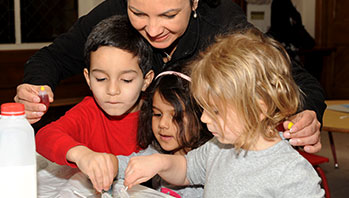- cups
- eyedropper
- pennies
- water
- drip
- drop
- shape
- squeeze
- stick
- surface
MA Standards:
Language/L.PK.MA.6: Use words and phrases acquired through conversations, listening to books read aloud, activities, and play.
Mathematics/Counting and Cardinality/PK.CC.MA.4: Count many kinds of concrete objects and actions up to ten, using one-to-one correspondence, and accurately count as many as seven things in a scattered configuration.
MA Draft STE Standards:
Earth and Space Sciences/Earth’s Systems/ESS2.A: Observe, investigate, and classify the non-living materials, natural and human made, in their environment.
Head Start Outcomes:
Logic and Reasoning/Reasoning and Problem Solving: Classifies, compares, and contrasts objects, events, and experiences.
Science Knowledge/Scientific Skills and Method: Uses senses and tools, including technology, to gather information, investigate materials, and observe processes and relationships.
Science Knowledge/Conceptual Knowledge of Natural and Physical Worlds: Observes, describes, and discusses properties of materials and transformation of substances.
PreK Learning Guidelines:
English Language Arts/Language 2: Participate actively in discussions, listen to the ideas of others, and ask and answer relevant questions.
Mathematics/Number Sense 2: Connect many kinds/quantities of concrete objects and actions to numbers.
Science and Technology/Inquiry Skills 3: Identify and use simple tools appropriately to extend observations.
Science and Technology/Physical Sciences 19: Explore, describe, and compare the properties of liquids and solids found in children's daily environment.
Small Group: Drops on a Penny

© Commonwealth of Massachusetts, Department of Early Education and Care (Jennifer Waddell photographer). All rights reserved.
STEM Key Concepts: Water can flow quickly or slowly; Water in small amounts forms drops; Water drops stick together; Water behaves differently on different surfaces
ELA Focus Skills: Listening and Speaking, Vocabulary
Tell students that they are going to continue to explore how water drops stick together, and how water drops behave on different surfaces. For this activity, have children explore drops of water on the surface of a penny.
Group children in pairs and give each pair a penny. Begin by asking children to observe the penny carefully. Invite them to explore the penny as you ask,
- What does the penny look like? What does it feel like?
- How is it different from other surfaces you have used in drops explorations?
Ask children to predict how the drops of water will behave when they let water drip on the penny using an eyedropper. Ask,
- Do you think the drops will stick to each other like they did on the wax paper? Why or why not?
- Do you think the drops will stick to the penny or roll off the edge? Why do you think so?
Provide each pair with an eyedropper, a cup of water, and paper for recording their observations. Show children how to carefully and slowly squeeze drops onto the penny by holding the eyedropper about one inch above it.
- Invite pairs to work together and suggest that one child squeezes the drops while the other child makes and records close observations.
- As they add drops encourage children to notice the size and shape of the drop(s) on the penny.
Encourage children to think and talk about water drops by inviting them to share their observations and by asking questions such as,
- How did the size of the drop(s) on the penny change as you added drops? How did the shape change?
- What did you notice about drops “sticking”? Were you surprised by how many drops stuck to the penny? Why or why not?
- What do you think it is about the penny that made the drops behave that way? If you cut out a circle of wax paper the same size as the penny and dropped water on it, do you think the drops would behave the same way? Why or why not?
